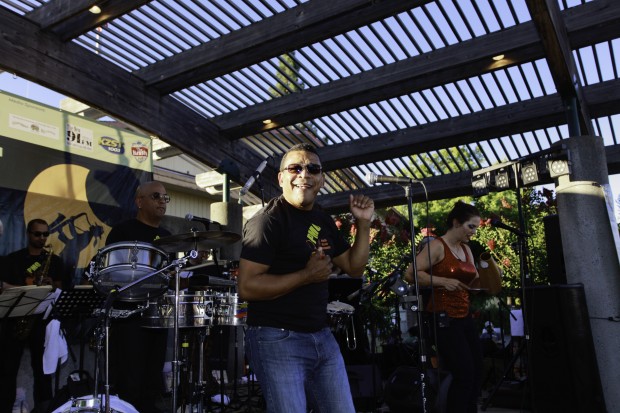I first learned about mambo as a kid when my father relayed a famous story about Perez Prado getting banned from Mexico for wanting to turn the country’s national anthem into a mambo tune. My dad loved that story. He tended to repeat himself, so I probably heard that tale a hundred times. In any event, decades before I was born, Prado was the reigning king of mambo, one of the first to ever introduce the form to America.
These days, San Jose claims its own heroic mambo arranger in Aaron Lington, who also coordinates the jazz studies program at SJSU. Along with the Pacific Mambo Orchestra (PMO), Lington just won a Grammy, and the band just happens to be among those tearing up the Salsa Stage at the San Jose Jazz Summer Fest this Friday. The band’s self-titled debut work, an independent, Kickstarter-funded CD, took home Best Tropical Latin Album, quite an accomplishment. Steffen Kuehn and Christian Tumalan are the bandleaders, while Lington did much of the arranging on the CD. The 19-piece band consists of four trumpets, four trombones, five saxophones, piano, bass, timbales, congas, bongos and Alexis Guillen on vocals—all of which harkens back to the classic mambo sounds of the ’40s to the ’60s.
As a band arranger, sax player and music professor, Lington says the project was a new challenge for him. On one hand, his experience arranging for big bands came in handy, since the lineup is not that different, but writing for mambo rhythms was not second nature to him.
“The instrumentation, horn-wise, is exactly the same as a regular, traditional big band,” Lington explains. “That part is the same, in the way that you voice for those instruments is exactly the same as if I was writing a Basie-style chart. A good Gm9 voicing with the 9 in the lead trumpet sounds good whether it’s being played with a Latin band or a jazz band. So those kinds of technical aspects are the same.”
But coming from a jazz and a classical background, Lington never did a whole lot of writing for clave-based rhythms until Pacific Mambo. Arranging for the 3-2 clave style was quite a bit different. He had to pore through Rebeca Mauleon’s acclaimed Salsa Guidebook to acquaint himself with how to arrange for those rhythms. In any event, his work paid off.
Lington says Kuehn and Tumalan gave gave him carte blanche to arrange the tunes however he wanted. He didn’t really have to edit much of anything. His initial ideas came out pretty solid and everyone seems to dance like mad during the gigs.
Lington’s arrangement of the Stevie Wonder track, “Overjoyed,” for example, is the most downloaded track on the album and the most requested tune when the band plays live. Lington’s own stamp can be heard during an interlude he threw into the arrangement. Ostinatos in the bari sax and bass trombones compliment diminished harmonies and timbale solos—quite a stretch for a mambo tune.
“I’m not saying everything I did is maybe one hundred percent accurate to the traditions,” Lington confessed. “But I would say it’s really pretty darn close. And I haven’t really heard any complaints from anyone.”
In fact, just the opposite happened. After some intense PR work promoting the heck out of the project, Pacific Mambo was nominated for a Grammy. They were overjoyed, but no one honestly thought it would go any farther than that.
“We were amazed to get nominated,” Lington says. “I was very surprised. Because we’re independent. And we were the only independent recording that was in the category. Everything else was Sony and all these major labels. We were up against Marc Anthony. I honestly thought that would probably be it. Still an amazing honor, but I thought for sure we’d lose to Marc Anthony. He’s huge.”
Pacific Mambo’s arrangements unfold at a frenetic pace, practically suited for dancing. Expect the ghost of Perez Prado to emerge from the woodwork and bless the Salsa Stage with his presence. As Tumalan announced at the Grammy Awards, from the podium: “The mambo is back. And it’s here to stay.”



